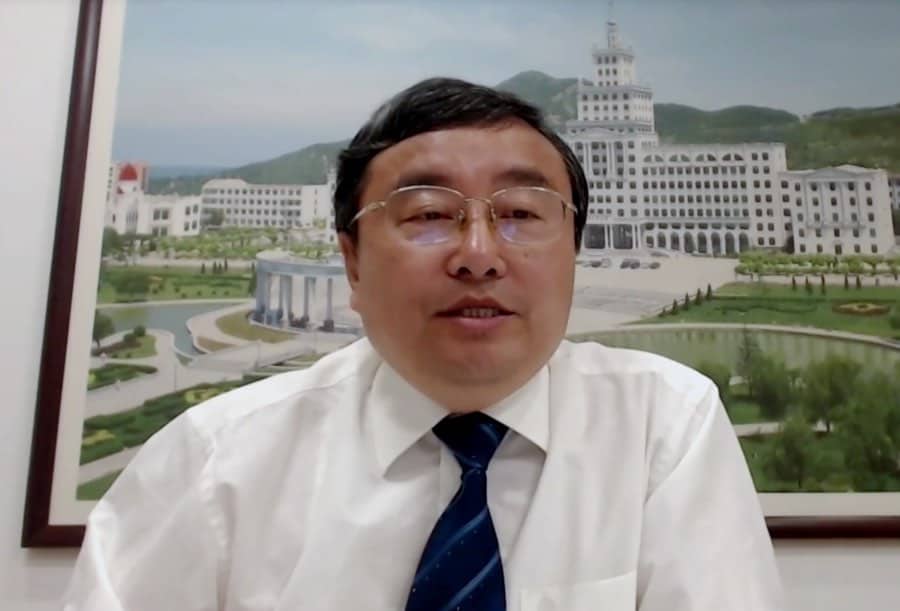
Above: Xu Xiaofei.
Chinese technology giant Huawei is staking territory in global education through its Tech4All initiative and convened a group of international partners and UNESCO representatives for an online webinar on Tuesday morning.
Conspicuously absent was any representative of US education concerns, unsurprising given the combative relationship the American government has stoked with the company over the last year.
Stefania Giannini, Education Assistant Director-General for UNESCO set the tone for the scope of the problem facing the education sector globally.
According to Giannini, 40 percent of lower and middle income countries have not been able to implement education after the shutdown.
She noted that six out of ten schools were not efficiently using online resources and expressed concern that the closure of schools could increase education inequities.
Through its Global Skills Academy, an education initiative to improve digital learning solutions, UNESCO has championed an integrated approach to teacher education, connectivity and integrated learning.
“Health and education are not competitive objectives,” Giannini said, “they are part of the same initiative to improve society.”
Inside the Digitruck
Tech4All, according to Ken Hu, Huawei’s deputy chairman, identifies education as a key focus area, specifically targeting the development of digital skills and enabling digitally connected schools.
The difficulties are real and widespread.
Borhene Chakroun, Director of Policies and Lifelong Learning Systems at UNESCO warned of problems with teacher preparedness for online instruction and noted the wide range of strategies used to close the education gap that followed covid19 restrictions.
Borhene Chakroun
The education response has been a mix of solutions, with 82 per cent using TV and radio, 75 per cent using an existing online platform, 62 percent using free and open platforms and 56 percent working to implement new online systems.
Online education must also acknowledge the reality that many countries have three tiers of accessibility, high-tech, low-tech and no-tech.
Senegal’s Seyni Ndiaye Fall, Coordinator of the National Education Information and Management System, explained that his country does not have a nationwide network, so despite work over the last few years on developing digital platforms for learning, the country had to manage significant accessibility challenges.
Huawei provided the University of Senegal with free tablets, but that only helped large cities and population centres.
Seyni Ndiaye Fall
A dedicated television education channel reached more students, and community radio pushed deeper into the countryside to provide education to communties which cannot receive a television signal.
Even further out, photocopy machines were deployed to distribute printed materials in communities without electricity.
Olivier Vanden Eynde, founder and CEO of Close the Gap, a Brussels-based NGO operating across Africa sources secondhand computer systems in Europe of recent vintage, refurbishes them and deploys them on the African continent.
The company has collected more than a million IT assets and deployed 175,000 computers for use. Equipment that reaches end-of-life in Africa is stripped for recycling there, and the precious materials exported to Europe for reuse. The company has exported 2,370 tons of e-waste for recycling.
The company has partnered with Huawei to create the Digitruck, to create an autonomous mobile classroom built in a refurbished shipping container with 20 laptop equipped workstations, VR headsets, solar power and mobile Internet.
Ten of these trailers are in use in Africa, in the Democratic Republic of the Congo, Tanzania, Kenya and South Africa.
“Education is not only about knowing to do, but knowing how to be.”
– Borhene Chakroun
Janice Richardson of Insight created a more upscale version of the Digitruck in partnership with Huawei in Europe.
Richardson found that formal online learning lags significantly behind YouTube and Wikipedia with just 35 per cent of young students using those systems to access instruction. YouTube dominated as an information resource capturing 80 per cent of users and Wikipedia followed with 60 per cent.
Despite better access, Richardson found that students visiting the Smartbus didn’t understand the fundamentals of online systems, could not readily identify legitimate sources of information and didn’t understand the value of creating a strong password.
Janice Richardson
Xu Xiaofei, Deputy Director of China’s Education Expert Advisory Group offered a picture of his country as demonstrating leadership in online education. China is aggressively behind the Massive Open Online Course model and plans to host a global MOOC summit in Beijing.
According to Xiaofei, 110 online education companies delivered more than forty thousand online courses free of charge on user-managed MOOC platforms.
“This is changing the role of teaching,” he said.
“Lecturers are now anchors and offering coaching. Students are moving from being listeners to actors and players. Universities are shifting from being managers to coordinators and supporters.”
Of the four models of teaching, MOOCs (unlimited participation, open access) and a variant, the Small Private Online Course (SPOC) usually taught in person, are seeing majority adoption in the Chinese education system compared to other systems of distance learning.
Borhene Chakroun, Director of Policies and Lifelong Learning Systems at UNESCO explained that globally the agency has found that as many as 50 percent of teachers have not received the training required for online learning,
That creates new problems with teacher capacity.
“Are we reacting or proacting?” Chakroun asked.
“The economic fallout will hit the most marginalised, and UNESCO wants to be proactive.”
The agency’s Global Education Coalition is responding with regional as well as country-specific teacher training.
“What will not change is our quest for quality,” Chakroun said
“Education is not only about knowing to do, but knowing how to be.”

